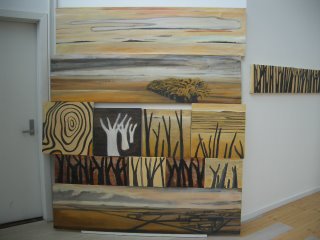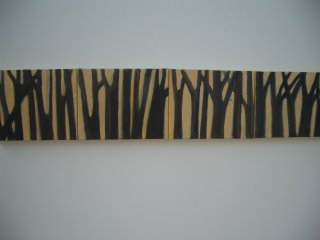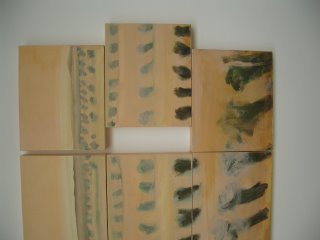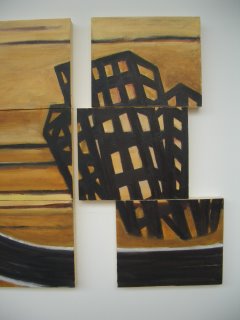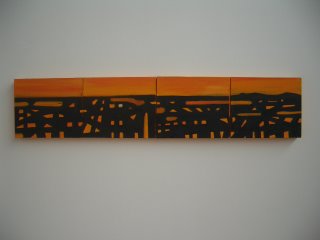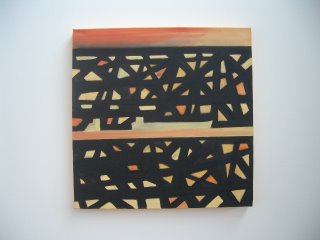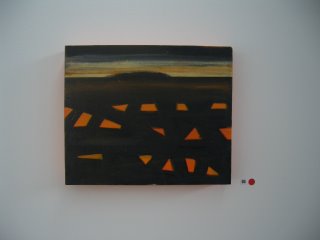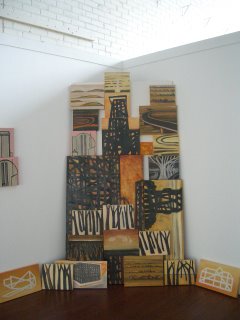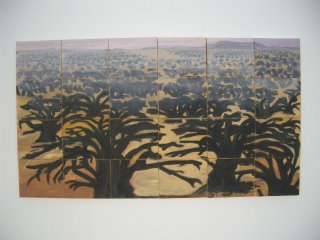
Sunday, January 11, 2009
Wednesday, March 28, 2007
Avenues of Honour

AVENUES OF HONOUR CAPTIONS
Bypass AVENUE OF HONOUR AT MYRNIONG (152 cms high x 152)
MYRNIONG is a quaint little settlement nestled in the hills not far west of Bacchus Marsh. It has been by-passed by a new section of the Western Highway but the Avenue of Honour has not been forgotten. It is well cared for and the western end (depicted here), which was almost buried by the road works, has been replanted quite recently.
When I first stopped to take a closer look, the last surviving trees were all but dead. What I thought I had found right there on the outskirts of Melbourne was a clear example of a place that had been bypassed by progress and long forgotten.
There are many such places around Victoria. I found quite a few of them out there in the course of my research but Myrniong is definitely not one of them. It was a nice surprise to go back there some years later and discover that the straggling survivors had been replaced, that proper markers had been erected and that another much more established avenue was thriving at the other end of the town. The country is very dry but the bypass has been good for Myrniong. It is a place that has a heart to it and the Avenue of Honour gives it dignity. It is the thread that holds it all together.
The Gates of Heaven AVENUE OF HONOUR KINGSTON (152 x 152)
Have you ever heard of Kingston? Not the sprawling metropolis that makes up a large chunk of Melbourne’s southern suburbs but Kingston via Creswick. Kingston is a tiny settlement with one man, a dog and a pub that opens at 3.00p.m. but at some stage in its history it was established as the seat of local government and laid out on a grand scale. Kingston, as its name suggests, was to have been a model metropolis. It never took off and that may be a blessing for us because what remains is a totally picturesque landscape distinguished by a wonderful avenue of European trees in pristine condition. It is regarded by those in the know as the classic example of an Avenue of Honour this side of the Champ D’Elysee.
It is certainly the most beautiful that I have had the privilege of seeing but I am not really interested in beauty. What interests me is the sense of history that is to be found there. I was thrilled to find the name of one of my own long lost relatives recorded on the obelisk at the top of the hill and moved by the sense that Kingston must have once been a thriving district. Where did everybody go that there should be just one man and a dog left standing? They stayed long enough to plant a magnificent testament to their sacrifice at war, put their roots down in that red earth and, like civilizations that went before them, shortly afterwards they disappeared. Some moved to Melbourne, some to Ballarat, some went to war and never came back. No doubt some stayed on to nourish the land with that sense of our history that we call belonging.
The pub offers roast dinner lunches on Sundays 12.00 to 3.00p.m. Definitely recommended if only for the surrounding landscape.
The Road to the Coast. AVENUE OF HONOUR, BASS (91 x 122)
Bass is on the South Gippsland Highway near the turnoff to Phillip Island. Actually it is just off the highway now and you can easily miss it.
For me the painting has a sense of a coastal landscape and holidaying at the beach. It was a real holiday to head off in that direction after my meanderings on the western front. I was looking for variety so I was pleased to find a row of great big lurching pines and a misty pink sky.
Strawberry pink skies may not be everybody’s cup of tea and trees that look more like something your granddaughter might bring home from kinder may not be your idea of a war memorial but for me this project needs to be as much about the future as it is about the past. How future generations will see these memorials is important. If all I had to do was represent what is there I am afraid these sites would pass by unnoticed. I have taken it as my job to bring them to the attention of a new generation and interpret them in such a way that they can have meaning for people whose connections to our history is remote. The medium has to be bold and loud and brash and crash if the message has any chance of getting through.
Roots in the Earth AVENUE OF HONOUR, BALLARAT (152 x122)
The Avenue of Honour at Ballarat extends from The Arch at for about 20 kilometres to Burrembeet at the outskirts of Ballarat where the new bypass rejoins the Western Highway. It provides a good measure of the grief that must have been felt by the people of the district in the aftermath of what the inscription on the arch refers to as The Big War. It is only one of dozens of such living memorials around Ballarat.
The names of those commemorated are listed on a tableau near the arch. Some died abroad. Most returned so it has to be said that the people who planted these trees were recording the pain of their terrible loss and the pride they felt in the contribution to the war effort that was made on their behalf.
It was for God and King and Country. These were the three great pillars that sustained them in their grief and gave them consolation but they are words which have lost much of their meaning in the intervening years. How could we translate them? To me “For the Greater Good” can barely suffice without a question mark but, for me personally, it makes sense to say that their sacrifice gave us our sense of who we are, where we have come from and where we are going and without that sense of direction we would be totally at sea in very frightening circumstances today. We would be lost.
Afternoon Rush VIETNAM MEMORIAL, AVENUE OF HONOUR, NORTH GEELONG (122 x 182)
There were a number of Avenues of Honour around suburban Melbourne. Most have been removed to make way for progress. A few remnants have been included in this show. There is still one at Cranbourne beside the racecourse. It would have made a good painting and I might yet get around to it. There is one at Mickelham, others at Narrewarren, Belgrave and but my quest was to find something gritty and urban; a place where the hustle and bustle of life went on regardless.
I had been up and down through North Geelong year after year and never noticed the Avenue of Honour on Melbourne Road. Thanks to Bob Christey’s collection my eyes were opened and I found just what I was looking for with bells and whistles added.
It is a memorial to the 50,000 Australians who served in Vietnam and the 500 who died there. LEST WE FORGET. I hope I have not offended anyone by also memorializing the last remnants of old growth forest from the Otways on their way to the chippery. It is all part of the great machine of how we live now and, ugly as it is, for me at least it is nice to know the Viet Vets are right there in the midst of it.
The trees were planted about 10 years ago and I am pleased to report that they are thriving.
Motor Vehicle Accident AVENUE OF HONOUR, BERRY’S CREEK (91 x 122)
The show would be incomplete without a real Australian bush setting. The approach to Berry’s Creek provided me with an appropriate break away from the more formal European style avenues I found elsewhere. It is about 15 k out of Traralgon but it could hardly be described as a settlement these days. Not surprisingly the creek is dry. There is a bridge but, as it turns out, it may well be a bridge too far because there is an element of doubt as to whether the fine avenue of elms beyond the archway really is an Avenue of Honour. We have found no one who can say for sure so please let us know if you have information.
The painting has been included because it makes a very pertinent point. Berry’s Creek shares its unconfirmed status with many other such sites around Victoria and there are probably others that no one still living knows anything about. It would be a great service to our history if someone came up with a few brass plaques.
Summer Afternoon AVENUE OF HONOUR, BACCHUS MARSH (91 x 122)
Bacchus Marsh is an old town en route to the Ballarat diggings but it is just 50 km from Melbourne and it fast becoming engulfed by the suburban sprawl. The Avenue of Honour forms a magnificent gateway to the town. It is probably the best known of all such memorials around Victoria. It is a particularly beautiful sight with about 2km of very healthy elms, orchards and market gardens alongside and roadside fruit stalls in the shadows. Glorious as the prospect is and much as these trees look like they have been there forever, they are still young. It was not so long ago that they were planted. Imagine that sunny afternoon, not a cloud in the sky, no hope of shade anywhere and the heads of the trees barely showing above the grass.
I am a landscape painter but I am not drawn to the wonders of nature. What interests me is the way in which we have changed the landscape in the course of our brief history here.
The Avenues of Honour are significant in this regard and Bacchus Marsh exemplary. Of everything out there bequeathed to us by 150 years of settlement the avenues of honour stand tall because they have a message addressed directly to us. We are the people of the future. It is about remembering where we have come from.
The message is often very personal, private and poignant especially in the case of those who died abroad. For the bereaved who could only ever dream of visiting Europe, these knee high little trees took the place of graves and as they grew they were tended accordingly.
I hope the exhibition serves to memorialize the memorializers, the mums and dads, brothers, sisters, lovers who went out there that sunny day; the pride they felt in laying out our history and the pain they must have carried with such a grievous loss. Remember them.
Country Boy AVENUE OF HONOUR, MORTLAKE (91 x 122)
The Shire of Moyne takes the cake for the best looked after Avenue of Honour that I have come across.
The Avenue of Honour at Mortlake consists of huge cypresses which are carefully trimmed into cylinders. The man who does the job informed me that, taking account of the circumference of each tree, there is 13 miles of trimming. That is dedication. I think that in the country, where time moves slowly, people live closer to their roots. The past is a living presence. The observation inspired this particular work.
I wanted to capture a sense of that boy, at age 16, out there on his first real job, being just like the boy who stayed at home, the youngest in the family who was left to help his mother on the property, his father and his brothers at the war and him itching to join them over there.
He is playing soldier but there is a cautionary note in the sign that he is holding. In the course of our research we came across various examples of fathers and their sons who never returned. It is just as well that this one stayed at home.
Night Driving AVENUE OF HONOUR, AMPHITHEATRE (182 x 122)
I had trouble finding the Avenue of Honour at Amphitheatre. There was no sign obvious. At the pub a debate that my enquiry sparked was just warming up when I walked out the door. It was getting late but I came across an old man at the cemetery on my way out of town. He had lived there in Amphi all his life. He sent me back to the bridge on the road to Avoca. In the 20’s there were nameplates on every tree. He knew every name. He used to walk that way to school. They were all heroes.
It was dark by the time I got there and very spooky.
I think my earliest awareness of the avenues of honour and everything they meant is inextricably confused with the “ghost gums,” (the quick and the overarching. ring barked, bleached white dead) and excursions into the dark unknown of the Victorian countryside at night. Thus the whole landscape became peopled with the sentinel spirits of long departed soldiers.
The Eighth Year of the Drought AVENUE OF HONOUR, LEARMONTH
Learmonth is a small town on the Sunrasia Highway about 20k northwest of Ballarat.
The Avenue of Honour consists of well-established elms on both sides of the road extending for about three kilometers. At one end a tableau records the names of people from the district who served in the two world wars and are honoured with a tree. There would be over two hundred names listed. Where are they now? Where are their descendants? The town (depicted in the second row) consists of a few straggling shops, as I remember it, a school, pub, service station, motel and maybe a few dozen houses but like other towns I went to on my various trips out there, Learmonth is a place long bereft of its population.
It is picturesque. The elms are gorgeous but its famous lake has been bone dry for years and the whole district has been savaged by the drought. When I was last there, main street was empty. It was 38 degrees. A hot northerly tore at everything. Even the hills in the far distance were being torn into shreds. That is how I remember it. That is what I have painted.
In Memory Dear AVENUE OF HONOUR, DEAN (60 x 120)
Dean is a tiny settlement in the heart of spud country. You will find it on a map on a back road between Creswick and Wallace not far from Ballarat. It was a total accident that I ever went there. All that remains of this once thriving township is a pub which closed down a few years ago, a school also defunct, five homes, a beautifully restored Mechanics’ Institute, a few poplars and an Avenue of Honour with a charming double gateway in stone and just 12 trees on the pathway leading up to the old school house.
It is very pretty country and the setting of the Avenue of Honour particularly endearing.
The inscriptions on the gateway lintels read as follows: “Honour the Brave” and
“In Memory Dear.” The twelve trees honour former pupils at the school who served in the First World War including (list each name, Lynn Lea has details) of whom (list the three) were killed in action. A number of their descendants still live in the district including Laurie May whose story of the May brothers is included in this exhibition.
As it turns out Pte Albert Yelland is long lost, great, great uncle, a man never even known to me, a man never so much as ever imagined so news of his death in France on 30th September 1917 came as a shock. It was a moment of great sadness. However there was rich consolation in finding my roots in that dark volcanic soil. It was an extraordinary experience, surreal in fact but, one might suppose, it is the kind of discovery that awaits anyone who goes out there looking beyond what we normally see.
Tuesday, January 16, 2007
Tuesday, November 07, 2006
Subscribe to:
Comments (Atom)



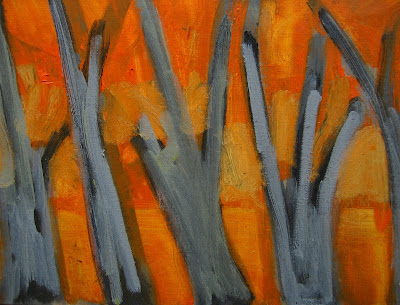



















.jpg)
.jpg)
.jpg)





.JPG)





